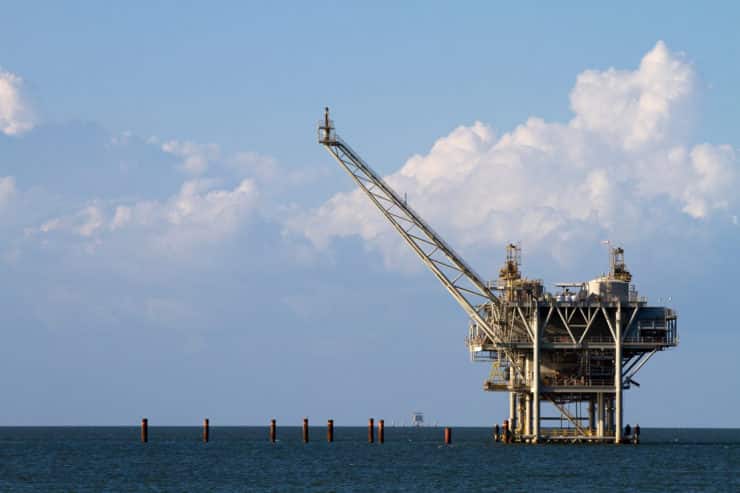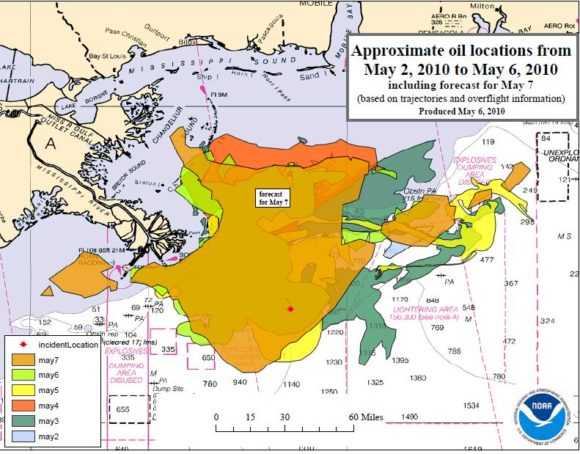FAQ
Deepwater Horizon Oil Platform Explosion and Response
On April 20, 2010, the oil rig Deepwater Horizon exploded about 50 miles off the Louisiana coast in the Gulf of Mexico. The explosion killed 11 workers and injured 17 more. Two days later it sank in 5,000 feet of water.
On the day of the explosion, oil began spewing into the Gulf from a broken pipe a mile below sea level. For weeks, the blown-out undersea well continued to stream crude oil at a rate of about 210,000 gallons per day, threatening the U.S. coastline.
Within days of the explosion, the nation was transfixed by frantic efforts of oil giant, BP and the federal government to plug the leaks and contain the massive spill threatening the gulf coastline and the ocean itself. People were able to watch the multiple failed attempts made to “cap” the well to stop oil from flowing into the Gulf. A livestream of the actual pipe, spewing oil on the ocean floor was available for viewing 24 hours a day.
By May 7, 2010, the oil slick had already reached several barrier islands off of Louisiana’s coast. Satellite images showed oil from the spill in the Gulf of Mexico extending west around the Mississippi Delta. Over a period of months, an estimated 4.9 million barrels or 210 million gallons of oil spewed into the Gulf of Mexico. It was the biggest oil spill in U.S. history,
The oil flow was finally controlled in September of 2010, five months after the explosion. Cleanup required miles of containment booms, nearly 2 million gallons of dispersant, oil-eating microbes and other methods – many of which also proved to be harmful and still millions of animals died, and thousands of people were left in financial ruin.
RESTORE Act Signed into Law
In July 2012, President Barack Obama signed an amendment to the Clean Water Act, known as the Resources and Ecosystems Sustainability, Tourist Opportunities, and Revived Economies of the Gulf Coast States Act (RESTORE Act). The RESTORE Act established a trust fund and incorporated the Gulf Coast Ecosystem Task Force’s work into a coordinated effort financed largely by BP and other involved corporations. The RESTOR Act was tasked with ecosystem restoration and economic development. It provided management and funds to local and state organizations, as well as funded monitoring and research programs.
In April of 2014, BP claimed that cleanup was completed but was quickly contradicted by the United States Coast Guard. In May 2019 – nine years after the explosion, the U.S. Coast Guard finally verified that the well had been capped and contained. Despite containment, the National Ocean and Atmospheric Administration Science Center (NOAA) has stated that 1,260 gallons of oil are still being collected daily.
Cost of Cleanup
The oil spill required closure of transport in the surrounding area, occupying over 6,000 watercraft including skimmers, research vessels, Coast Guard cutters and other specialized vessels. Efforts at containment and immediate cleanup involved approximately 48,000 people including the authorization of 17,500 National Guard Members. Private residents, business owners and volunteers also participated in local cleanups.
Economic damage mounted into the tens of billions of dollars with forced business closures, loss of state and local revenue, unemployment, property damage and other costs. Many residents and people who participated in cleanup efforts developed illnesses related to petroleum and chemical exposure. Some of these illnesses have been persistent, chronic or permanent, serious and even life-threatening.
Nearly $70 Billion has been spent by BP on cleanup and the company has participated in several settlements with businesses, individuals, and governmental agencies. Companies which owned and operated the platform and drilling rig, Halliburton, Transocean, Anadarko and MOEX, have also paid an estimated $60 Billion. The State of Louisiana and its residents, along with those of Mississippi and Alabama, still deny that recovery is complete. Deepwater Horizon oil continues to be detected in the food chain. Studies of both wildlife and human impacts remain ongoing and health problems continue to persist.
Industry Impacted by Gulf Oil Spill
The oil spill affected use of the Louisiana Offshore Oil Port. The port, known as LOOP, is one of the leading facilities for imported oil, handling up to 1.2 million barrels a day and feeding half the nation’s refinery capacity. Price of fuel, plastics and other petroleum products may have been impacted by the closure and offshore drilling was curtailed for a period of time.
The fishing industry was the fastest and hardest hit industry with federal officials expanding off-limits fishing area from 6,800 to 10,800 square miles in the northern gulf . Louisiana officials closed shrimping in state waters from South Pass of the Mississippi to the eastern shore of Four Bayous Pass just east of Grand Isle. Earlier, state waters east of the Mississippi were closed to seafood harvesting, leaving thousands of fishermen idle with no source of income. Other states including Florida, Alabama and Texas coastlines were also impacted.
Public Health Effects of Gulf Oil Spill
Health authorities and medical personnel have reported both short and long-term health effects related to exposure to petroleum. Many of these physical effects may have developed into chronic health conditions. In addition, Gulf residents and others affected by the cleanup, including cleanup workers have experienced psychological problems including depression, anxiety, insomnia, and increased rates of domestic violence.
Gulf Oil Spill Legal Resource Center
Seeger Weiss co-founded the BP Oil Spill Legal Network, a national coalition of lawyers working to assist in recovering the losses suffered from the April 20, 2010, BP oil spill in the Gulf of Mexico.
Gulf Coast Oil Spill Government Fines and Settlements
By 2010, hundreds of lawsuits were already filed by workers and their families, business owners and residents who had been harmed by the Gulf Oil Spill of Deepwater Horizon. BP Exploration and production Inc., along with other companies who owned and operated the Deepwater Horizon platform and drilling rig were named in lawsuits.
BP and others also faced criminal charges and civil lawsuits filed by federal, state and local agencies including the Environmental Protection Agency, Department of Justice and agencies from Louisiana, Mississippi, Alabama, Texas and Florida.
Fines and settlements paid to government agencies reached over $20 billion and resulted in multiple felony convictions for BP executives and criminal convictions against others.
Gulf Coast Oil Spill Class Action and Other Lawsuits
In 2012, BP agreed to pay approximately $8 billion to settle 100,000 claims filed by businesses and individuals, though the amount of total payments was not capped. By 2013, the estimate of payments was boosted to $10 billion but BP recognized it could be much higher.
The company later attempted in 2014 to deny payments for lawsuits they claimed were “fictitious and absurd” however the complaint was rejected by the U.S. Fifth Court of Appeals. The same court ruled in 2015 that the company had the right file for review of claim awards but also determined that non-profit organizations were eligible to claim payments.
By 2018, settlement compensations reached nearly $12 billion for BP, with an additional $1 billion from Haliburton. Lawsuit settlements included lost profits, property damage, sales losses, subsistence use coverages for businesses. Individuals also received coverage for damage to property, as well as medical claims including medical consultations for 21 years.

